
Woohoo, finally it’s that time of the year again – the EuroSTAR Conference is on. This year it took place as an online edition which gave people from all around the world the opportunity to take part in this amazing conference without needing to travel during the pandemic times.
Although it is an online edition, there was plenty of space to meet other attendees. You could do a speed meet sessions and talk to someone randomly for 3 minutes. You could join a lean coffee session and discuss interesting topics. You could get solutions to your problems from the Test Clinic. Or you could check out the demos of the sponsors and stroll through the Expo area.
The Programme Committee around the Programme Chair Fran O’Hara made an amazing job when choosing the speakers for this year’s edition and you could listen to talks from different areas of testing, speakers with different backgrounds and from different cultures. Let me summarize my first day at the EuroSTAR Conference 2021 by using my sketchnotes.
Moving to frequent releases. The 10 Communication Principles that support rapid change.
Rob Lambert
The first keynote of the day was held by Rob Lambert. Rob started by explaining the 5 step thinking model. First, you paint a picture of the bright future (like a vision). Then you lean into the problem and ask if the team is the right one to get it done. Afterwards it’s all about routines, habits, disciplines and processes, and finally there is a lot of learning.
He then talked about the 10 (+1) Communication Principles to support rapid change. These are:
- Enthusiasm
- Purpose, audience, context
- Communication is something the listener does
- Use stories
- Don’t waste people’s time
- Practice is preparation
- People remember how you make them feel
- Non-verbal is a superpower
- People resonate with those who sound like them
- You can hack your body
- Listening is the greatest compliment
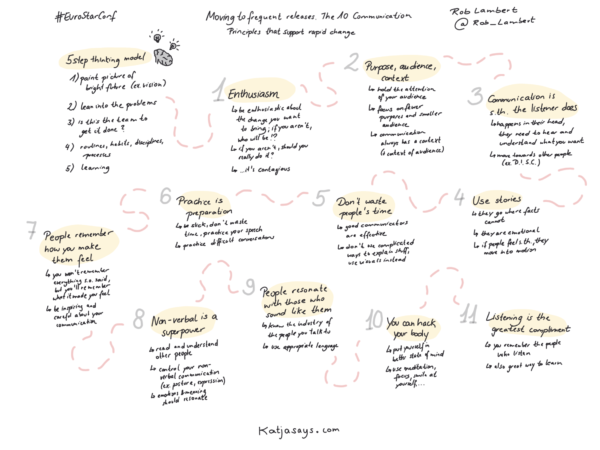
Quality is not about testing … it’s about value!
Gitte Ottosen
Gitte thinks that is not that easy to define what quality is, as it doesn’t mean the same to everybody. It is the value to some person, at some time, who matters. So you have to find out who the people that matter are.
More important, you have to think about what value means to you and get a common understanding throughout the whole team. You can do so by using the VOICE Model: Value, Objectives, Indicators, Confidence, Experience. As value is time dependent, you have to think about what you want to get out of the things you do right now – this will change over time.
5 myths and anti-patterns to refactor out with continuous performance
Paul Bruce
Nowadays, organizations want to deliver things quickly. They run into a more continuous future where they do smaller releases more often and share knowledge along the way. This only works if continuous performance feedback is given.
Paul used 5 myths/anti-patterns to explain how to get to having a continuous performance mindset:
- Prohibite Ubiquity
- Expedited Gridlock
- Mandated Ignorance
- Escape Philosophy
- Predictable Unreliability
Have a look at my sketchnote to learn more about the mantra and possible actions for each anti-pattern.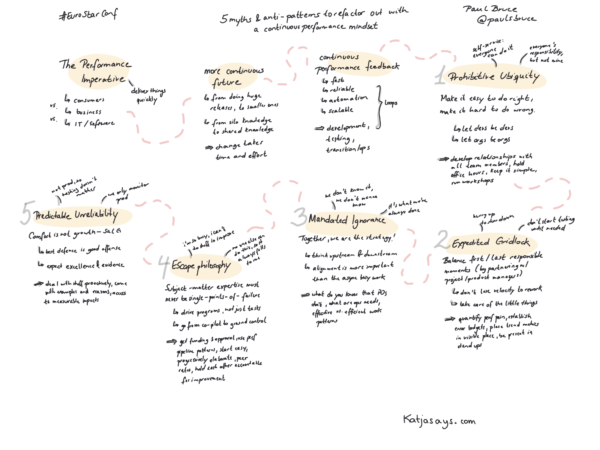
CSI testing – investigate like a pro
Adam Matlacz & Elzbieta Sikora
Adam and Elzbieta think that exploratory testing brings many opportunities for testers, especially when the sessions are held with people with different roles. While being a tester, you can behave like a detective when you are on a bug hunt. That’s how they came up with CSI Testing.
The CSI Principles are: Concentration, System thinking and Impartiality (+ break the rules). Focus on a goal, use a holistic approach and treat all fair without prejudices. A CSI Tester should build skills around different types of thinking, tools and gadgets and approaches and techniques.
The CSI Procedure would look like that:
- Approach the scene: Find out what you deal with
- Start investigation: Narrow down
- Release crime scene: Team work
- Conduct the trial: Confront suspects, call witnesses, judgement
- Debriefing: Retrospect
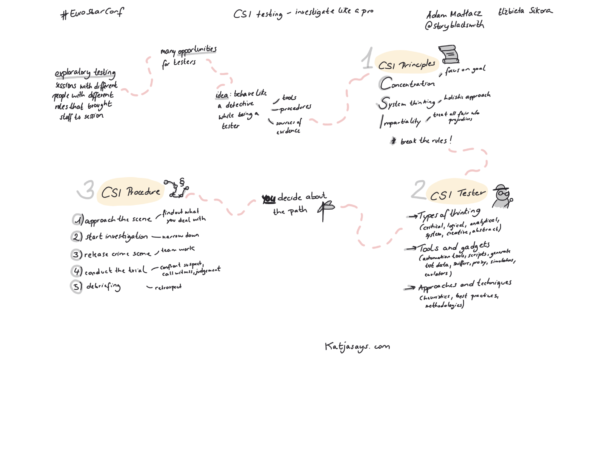
Lightning Strikes
Lightning Strikes are short talks of 5 minutes in which 2 slides are allowed. This year there were 8 speakers who were giving a lightning talk.
Lightning Strikes 1
Tariq King, Sanne Visser, Rob Meaney & Elise Carmichael
Tariq thinks that the world is full of bad software and by filling AI & ML systems with bad data and biases, the problem is being made even worse. By testing your software and using a holisitic approach, you can unlock a revolution and make a difference.
The essence of Sanne’s talk is, that you should always remember that there are different ways to get to where you want to get and that you should take a look around and think outside the box to not get stuck on the way things should be.
Rob shared two philosophies with us: Seek problems, solve problems share lessons, which is basically about sharing what you’ve learned with everyone and working in a holistic matter to enhance quality. The other one is: Fewer, smaller things together – which means fewer as in the variety/volume of work, smaller as in slicing things down more and together as in cross-functional teams that start and finish together.
Elise thinks that next to maintaining, analyzing and creating tests there is a huge portion of test debt, a backlog of work not done. She thinks that flipping the test pyramid upside-down helps you to refocus on the customer’s experience and therefore also reducing some of this debt.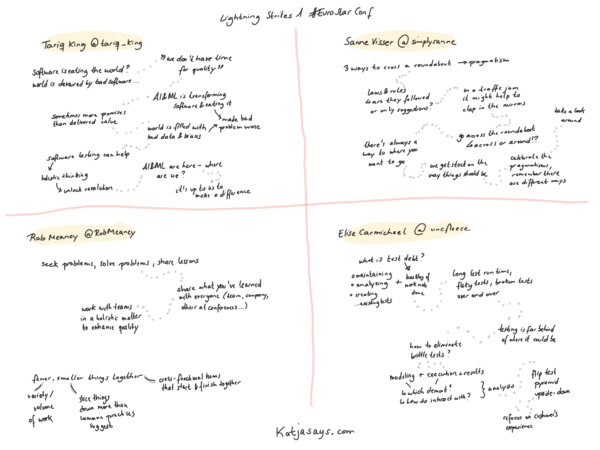
Lightning Strikes 2
Raj Subrameyer, Dawn Haynes, Chris Armstrong & Sowmya Ramesh
Raj compared pre- and during covid work to each other and found that from having onsite interviews, working from home as a luxury, limited virtual meetings and mandatory travel it all transfered to no onsite interviews, work from home as a necessity, virtual meetings as a normality and travel not existing any more. This leads to a huge change in the future of work in which a social media footprint, personal branding, remote working, going the extra mile and re-tooling your skillset become crucial.
Dawn’s approach to finding and hiring awesome testers is usins these attributes of a CRACK tester:
- Curious
- Resourceful
- Adaptable
- Creative
- Knightly
In short, Chris’ talk is about not overlooking any rules when doing test automation. A small mistake as letting someone and not the whole team decide on which tool to use might turn into a huge problem.
Experimentation is pivotal to success. Sowmya encourages us to be open to changes, so that we don’t lose any opportunities. But while experimenting, you should not forget to do extensive research, monitor and measure, improvise as required, document the lessons learned and implement with confidence.
The seeds of toxicity we’ve been trained to overlook at work
Raj Subrameyer
Raj has been dealing a lot with stereotyping and racism himself – mostly microagressions (actions/words that can be offending). He discovered that those often appear at work places and should definitely be fought. He has 5 proposals on how to curb microagressions:
- Diversity & inclusion training
- Having open conversations
- Own your mistakes
- Anonymous help hotline
- No tolerance policy
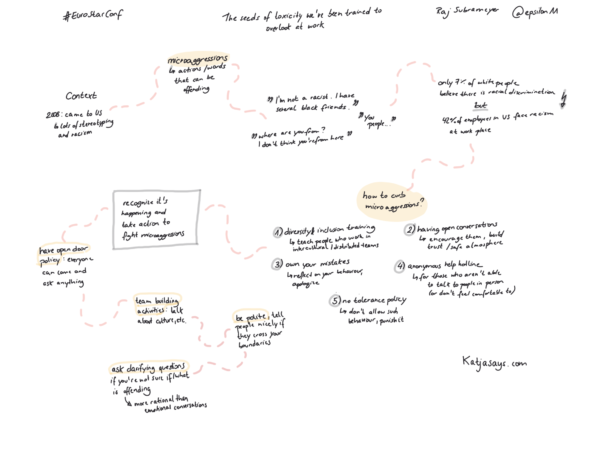
Continuous performance testing in DevOps
Lee Barnes
Traditional performance testing, which often comes too late and takes too long, is dead. Continuous performance, which means evaluation at each stage and more frequent feedback, is uprising. But you have to think about performance factors early on in your development process. Incorporate the requirements as contraints or/and as acceptance criteria for existing user stories.
Lee advises us to start small and expand to move from a centralized to an integrated performance team. Gather feedback and continuously improve.
Testing and monitoring in production is important, but don’t forget to consider to:
- eliminate requests to 3rd parties
- ensure system “knows” that it’s being tested
- identify an ideal test window
- coordinate with infrastructure providers
- solicit broad IT input
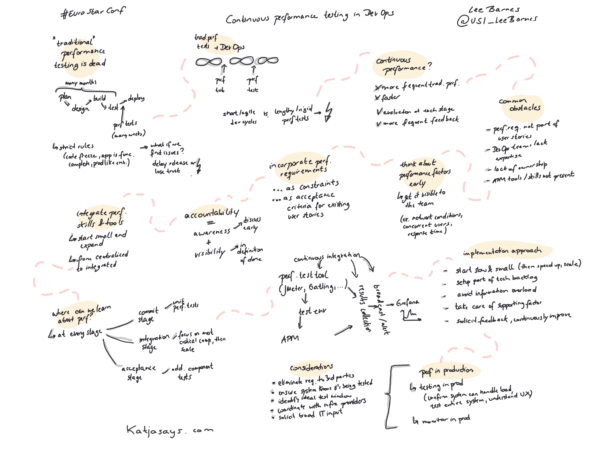
The journey of testing software for DNA analysis
Aprajita Mathur
The last keynote of the day was held by Aprajita Mathur. She was talking about testing software for DNY analysis. The standard workflow for analysis of genome sequence data is:
- Alignment
- Reference Genome
- A) Somatic or B) Germline variant calling
- Variant filtering & annotation
- Data visualization & reporting
Machine learning applications help testing and can be supervised, unsupervised or predictive. While testing – also called Bioinformatics Analysis Pipelines – keep in mind:
- Statistical models are used
- The models are trained on data sets
- The model is as good as the data or worse
- You aren’t testing the exact output, but expected behaviour
- You have to test in different situations
- There are lot of changes, which lead to complexity, but also exploration and fun
Between testing software for DNA analysis and “normal” software testing there are a lot of common grounds. But to DNA analysis, there are also some challenges as Gold Standards, domain knowledge, population genomics and that nature always has its way.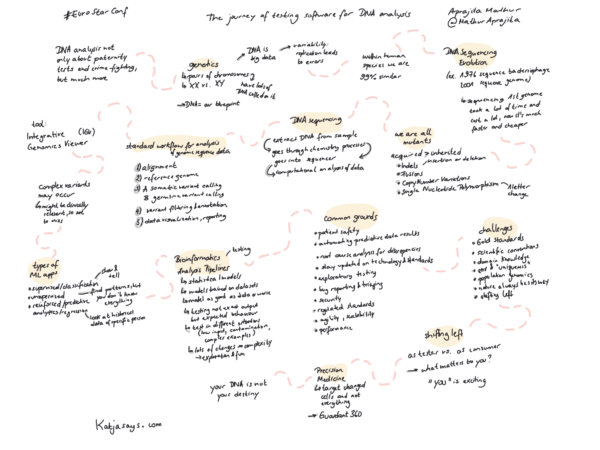
As you can see, on the first day of EuroSTAR 2021 there were a lot of different topics already. From communication principles over performance testing and racism at work to testing software for DNA analysis – that’s what I call a huge variety. And there are so many talks that I haven’t attended and might re-watch after the conference.
About The Author

Katja Budnikov is a software tester and sketch noter from Northern Germany. Katja is passionate about software testing and sketch noting! She loves attending events like EuroSTAR and sharing her experience and learnings with others on her blog Katjasays.com. Katja first started sketchnoting in 2016. First analogue with pen and paper and now digitally with an iPad and Apple Pencil.
In her work life Katja started out in online marketing, then specialized in search engine optimisation and is now a quality assurance specialist in both manual and automated software testing. Away from work Katja loves photography, especially taking photos of nature, including many of her dog Auri, a young Australian Shepherd, who is super cute and fun to take photos of. She loves to spend time with her dog and partner, going out for walks, traveling and eating cake at a nearby coffee shop with a beautiful garden.